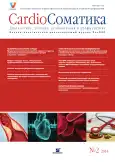Predictors of development of cardiovascular events after stenting of coronary arteries at patients with obesity
- Authors: Veselovskaya N.G1,2, Chumakova G.A1,3, Gritsenko O.V1,3, Mironova N.G2
-
Affiliations:
- SCIENTIFIC RESEARCH INSTITUTE of integrated problems of cardio-vascular diseases SB RAMS, Kemerovo
- Altai Krai cardiological clinic, Barnaul
- Altai State Medical University of the Ministry of health of Russia, Barnaul
- Issue: Vol 5, No 2 (2014)
- Pages: 5-9
- Section: Articles
- URL: https://journals.rcsi.science/2221-7185/article/view/45068
- DOI: https://doi.org/10.26442/CS45068
- ID: 45068
Cite item
Full Text
Abstract
Full Text
##article.viewOnOriginalSite##About the authors
N. G Veselovskaya
SCIENTIFIC RESEARCH INSTITUTE of integrated problems of cardio-vascular diseases SB RAMS, Kemerovo; Altai Krai cardiological clinic, Barnaul
Email: nadezhda100@rambler.ru
канд. мед. наук, ст. науч. сотр. отд. мультифокального атеросклероза ФГБУ НИИ КПССЗ СО РАМН, врач КГБУЗ АККД
G. A Chumakova
SCIENTIFIC RESEARCH INSTITUTE of integrated problems of cardio-vascular diseases SB RAMS, Kemerovo; Altai State Medical University of the Ministry of health of Russia, Barnaul
Email: g.a.chumakova@mail.ru
д-р мед. наук, проф. каф. госпитальной и поликлинической терапии ГБОУ ВПО АГМУ, вед. науч. сотр. отд. мультифокального атеросклероза НИИ КПССЗ
O. V Gritsenko
SCIENTIFIC RESEARCH INSTITUTE of integrated problems of cardio-vascular diseases SB RAMS, Kemerovo; Altai State Medical University of the Ministry of health of Russia, Barnaul
Email: qritzenko.olesia@mail.ru
аспирант каф. госпитальной и поликлинической терапии ГБОУ ВПО АГМУ; науч. сотр. отд. мультифокального атеросклероза НИИ КПССЗ
N. G Mironova
Altai Krai cardiological clinic, Barnaul
Email: g.a.chumakova@mail.ru
зав. отд-нием КГБУЗ АККД
References
- Dogdu O, Yarlioglues M, Kaya M.G et al. Long term clinical outcomes of brachytherapy, bare - metal stenting, and drug - eluting stenting for de novo and in - stent restenosis lesions: Five year follow - up. Cardiol J 2011; 18 (6): 654-6.
- Чумакова Г.А., Веселовская Н.Г., Козаренко А.А. Эпикардиальное жировое депо: морфология, диагностика, клиническое значение. Сердце. 2011; 10 (3): 143-7.
- Mazurek T, Zhang L, Zalewski A et al. Human epicardial adipose tissue is a source of inflammatory mediators. Circulation 2003; 108 (20): 2460-6.
- Eiras S, Teijeira-Fernández E, Shamagian L.G et al. Extension of coronary artery disease is associated with increased IL-6 and decreased adiponectin gene expression in epicardial adipose tissue. Cytokine 2008; 43 (2): 174-80.
- Gensini G.G. A more meaningful scoring system for determining the severity of coronary heart disease. Am J Cardiol 1983; 51 (3): 606.
- Национальные клинические рекомендации «Диагностика и лечение метаболического синдрома» (второй пересмотр). Кардиоваскулярная терапия и профилактика. 2009;8 (6; Прил. 2): 4-6.
- Диагностика и лечение артериальной гипертензии. Российские рекомендации (4-ый пересмотр). М., 2010.
- Iacobellis G, Willens H.J. Echocardiographic Epicardial Fat: A Review of Research and Clinical Applications. JASE 2009; 22 (12): 1311-9.
- Carcagni A, Milone F, Zavalloni D et al. Absence of gender difference in immediate and long - term clinical outcomes after percutaneous transluminal coronary angioplasty in the stent era. Eur Heart J 2003; 24: 478-86.
- Iacobellis G, Assael F, Ribaudo M.C et al. Epicardial fat from echo - cardiography: a new method for visceral adipose tissue prediction. Obes Res 2003; 11 (2): 304-10.
- Ahn S.G, Lim H.S, Joe D.Y. Relationship of epicardial adipose tissue by echocardiography to coronary artery disease. Heart 2008; 94 (3): 7-13.
- Jeong J.W, Jeong M.H, Yun K.H et al. Echocardiographic epicardial fat thickness and coronary artery disease. Circ J 2007; 71 (4): 536-9.
- Han S.H, Quon M.J, Koh K.K. Reciprocal relationships between abnormal metabolic parameters and endothelial dysfunction. Curr Op Lipidol 2007; 18 (1): 58-65.
- Piatti P, Di Mario C, Monti L.D. Association of insulin resistance, hyperleptinemia, and impaired nitric oxide release with in - stent restenosis in patients undergoing coronary stenting. Circulation 2003; 108 (17): 2074-81.
- Bienertová-Vask J.A, Hlinomaz O, Vask A. Are common leptin promoter polymorphisms associated with restenosis after coronary stenting? Heart Vessels 2007; 22 (5): 310-5.
- Ichikawa T, Unoki Н, Sun Н et al. Lipoprotein(a) promotes smooth muscle cell proliferation and dedifferentiation in atherosclerotic lesions of human apo(a) transgenic rabbits. Am J Pathol 2002; 160 (1): 227-36.
- Fan J, Watanabe Т. Inflammatory reactions in the pathogenesis of atherosclerosis. J Atherosclerosis and Thrombosis 2003; 10 (2): 63-71.
- Kamitani T, Taniguchi T, Miyai N. Association between plasma lipoprotein (a) concentration and restenosis after stent implantation. Circ J 2005; 69 (6): 644-9.
- Qin S.Y, Liu J, Jiang H.X. Association between baseline lipoprotein - levels and restenosis after coronary stenting: Meta - analysis of 9 cohort studies. Atherosclerosis 2013; 227 (2): 360-6.
- Szkodzinski J, Blazelonis A, Wilczek K et al. The role of interleukin- 6 and transforming growth factor - beta1 in predicting restenosis within stented infarct - related artery. Int J Immunopathol Pharmacol 2009; 22 (2): 493-500.
- Wang L, Goalstone M.L, Draznin B. Molecular mechanisms of insulin resistance that impact cardiovascular biology. Diabetes 2004; 53: 2735-40.
- Bonora E, Kiechl S, Willeit J et al. Insulin resistance as estimated by homeostasis model assessment predicts incident symptomatic cardiovascular disease in Caucasian subjects from the general population: the Bruneck Study. Diabetes Care 2007; 30: 318-24.
- Lima-Filho M.O, Figueiredo G.L, Foss-Freitas M.C. Predictors of restenosis after percutaneous coronary intervention using bare - metal stents: a comparison between patients with and without dysglycemia. Braz J Med Biol Res 2010; 43 (6): 572-9.
- Corpus R.A, O’Neill W.W, Dixon S.R. Relation of hemoglobin A1c to rate of major adverse cardiac events in nondiabetic patients under - going percutaneous coronary revascularization. Am J Cardiol 2003; 92: 1282-6.
Supplementary files







